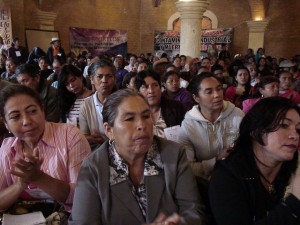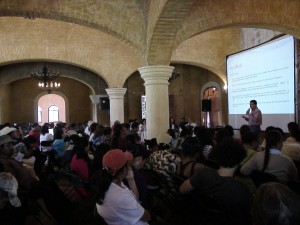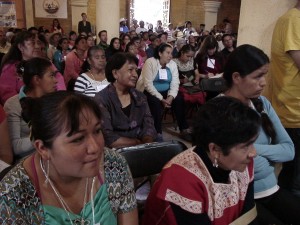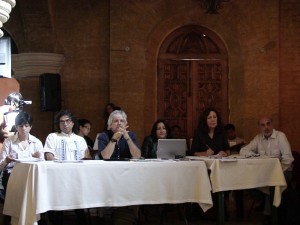 Hundreds of members of organizations fighting social and environmental catastrophes in their communities denounced a “national emergency” in Mexico’s water systems. Participants in the national hearing of the Permanent People’s Tribunal, Mexico chapter on the “Devastation of National Hydrologic Systems” held in San Miguel de Allende, Guanajuato, Sept. 20.
Hundreds of members of organizations fighting social and environmental catastrophes in their communities denounced a “national emergency” in Mexico’s water systems. Participants in the national hearing of the Permanent People’s Tribunal, Mexico chapter on the “Devastation of National Hydrologic Systems” held in San Miguel de Allende, Guanajuato, Sept. 20.
The Tribunal, headquartered in Rome and inspired by the Russell Tribunal that judged war committed in Vietnam war, is considered an “ethical tribunal”, meaning that although its sentences are not legally binding, it seeks to bring to light human rights violations against the peoples, coordinate and provide a public forum to citizen’s complaints, and pressure governments to assume responsibility for their acts.
The Mexico chapter is hearing cases of abuse of power by the Mexican state in benefit of national and foreign companies and attacks on the rights of the population. It is divided into seven areas: dirty war, structural violence and impunity; violence against migrants and forced displacement; femicide and gender violence; workplace violence and violations; destruction of agriculture and native corn; environmental destruction; and misinformation, censure and violence against journalists to document nationwide violations of rights generated particularly in the context of the North American Free Trade Agreement (1994) that opened up the country to foreign investment and the entry on a massive scale of transnational corporations.
The cases presented to a panel of experts reflect serious social problems that are hidden in the media and unattended by federal and local governments. They also provide a basis for further potential legal actions in national and international courts.
Collapse of the nation’s water systems
Thirteen cases were presented at the San Miguel hearing to demonstrate, through personal testimony of victims and in-depth studies, the destruction of watersheds and hydrologic systems that have caused multiple damages to the local and regional populations, violations of individual and collective human rights, health problems and environmental destruction. All cases reported a lack of access to and response from the Mexican justice system to stop damages and redress harm.
Representatives of community groups and non-governmental organizations from throughout the country denounced their cases, the vast majority presented by women who make up the bulk of local activism in defense of water. The jury divided the cases into three blocks: water pollution, over-exploitation of aquifers (water depletion), and water diversion.
The host organization, the Coalition in Defense of the Independence Watershed (CODECIN) stated that the aquifers in their region of Guanajuato have been depleted, resulting in deeper wells to supply water. The lower level water is full of minerals toxic to human beings.
 The area of the Laja River, including San Diego de la Unión, Dolores Hidalgo, San Miguel de Allende and four other townships distributed in 7,000 km2 — a fourth of the state of Guanajuato—face problems of desertification, depletion of aquifers and contamination of water with fluoride and arsenic.
The area of the Laja River, including San Diego de la Unión, Dolores Hidalgo, San Miguel de Allende and four other townships distributed in 7,000 km2 — a fourth of the state of Guanajuato—face problems of desertification, depletion of aquifers and contamination of water with fluoride and arsenic.
The aquifer is intensively pumped to provide water for nearly 60,000 hectares of irrigation, most for large-scale export crops, favored with low water rates and subsidized rates for electricity and other services.
Fluoride and arsenic are found in the water for human consumption from two to ten times the official norm. Fluoride causes osteoporosis, pain in the bones and the elimination of enamel on the teeth leading to staining and deterioration. Arsenic causes neurological damage and cancer, among other serous affects.
Following the scientific studies, five women from local villages described the health affects. A woman from Terreros broke down in tears as she narrated how her children have suffered as a result of the health effects of fluoride poisoning and the lack of response from government authorities, despite being aware of the problem for years.
“We still are seeing little children with stained teeth,” she said. “The water is running out, we don’t know how long we have left.” She said it cost nearly two thousand dollars to fix her oldest daughter’s teeth. Her husband was forced to migrate to the United States and she cannot afford medical attention for her children’s multiple ailments.
When the moderator asked for all those affected by poison drinking water in the Independence watershed to stand up, a stir went through the audience. More than a hundred men, women and children rose—many with evident signs of harm in the skin and teeth.
The organizations Consejo Estatal de Pueblos Indígenas de Guanajuato, Va por San Miguel de Allende, Charco del Ingenio and Frente Pro Patrimonio added the problem of the highway proposed between the cities of Silao and San Miguel de Allende. The highway would destroy wetlands, divide rivers, and damage more than 70 important archeological and cultural sites. The project consists of building a 60-meter wide highway, whose approval process lacked an adequate environmental impact study or consultation with local indigenous and nonindigenous populations.
The group Lagunero Citizens Association presented another case of overexploitation of aquifers due to unrestricted use by private industry. In the northern region of La Laguna, located in parts of the states of Coahuila and Durango, the dairy production giant, LALA, has been the main factor in water depletion, local residents stated. The company has leased or bought land from ejidos and local communities and controls 80% of the water supply in the region. It takes 2,400 liters of water to produce a single liter of milk, leading to massive drilling of new wells and deepening of existing wells.
“The stain of arsenic is spreading and has now reached the cities, due to overexploitation of the aquifer,” explained a local activist. She concluded, “more than a million residents of La Laguna are now exposed to arsenic, while some twenty businessmen benefit from the problems faced by the rest of the population.”
The economy in this part of the country had already been devastated by free trade policies that wiped out cotton production and prolonged droughts exacerbated by climate change. Rural dwellers have been forced to hire out as day laborers on cattle ranches or the offshore assembly plants (maquiladoras) or cross the border to the United States to look for work. Now the lack of clean water is another obstacle.
“When the water runs out, LALA can just grab their cows and go somewhere else, but what are we supposed to do?” asked the presenter from the local water defense group.
The Coalition for Atoyac Alive related that the Atoyac River, in Puebla and Tlaxcala, is one of the ten most contaminated rivers in the country. Residents reported that its repulsive odor and toxic fumes invade their communities and it gets worse at night, creating an almost unbreathable atmosphere.
Since the eighties, three industrial parks operate in the region with factories of ceramics, thread and cloth, and food colorings. The textile, soft drink, pharmaceutical and agroindustrial industries all use the river for their production in the area and there is also a petrochemical complex owned by PEMEX, the national oil company.
The local organization documented a history of neglect by government officials. They claimed that the federal government has violated laws in failing to apply environmental laws and favoring industrial use of water over domestic and agricultural use. Authorities do not carry out inspections, or apply regulations, they have not developed sanitary programs or programs for prevention and attention to victims of pollution and poisoning.
The result is water grabbing from communities to industry and many economic and social impacts, including the devaluation of their crops on the market since they are watered with contaminated water, gravely affecting their livelihoods.
Faced with high levels of toxicological damage, illness and disease including cancer, the local organization demanded closure of highly toxic industries that dump residues in the river and announced that they will keep up the pressure because “there is no social justice without environmental justice”.
Lethal Contamination
 Perhaps the worst case of industrial water pollution presented in the hearing came from the state of Jalisco, home of the Rio Santiago. A brief video shows scenes of a river white with chemical foam, a victim of uncontrolled discharges from factories and the sewage from the city of Guadalajara that is dumped into the river. More than a thousand contaminants, including heavy metals, converge in a toxic stew in the previously pristine waters o the Santiago.
Perhaps the worst case of industrial water pollution presented in the hearing came from the state of Jalisco, home of the Rio Santiago. A brief video shows scenes of a river white with chemical foam, a victim of uncontrolled discharges from factories and the sewage from the city of Guadalajara that is dumped into the river. More than a thousand contaminants, including heavy metals, converge in a toxic stew in the previously pristine waters o the Santiago.
More than 120,000 people live in El Salto, 20,000 in the county seat. The population suffers from many illnesses, as well as the loss of agricultural activities, and the deterioration of its lands and livelihoods.
Industry causes 80% of the pollution, dumping sulfuric acid and arsenic into the river. The loss of the river is a fact of life for residents. “No one in their right mind would dare to drink from that river,” the representative of El Salto for Life, the local environmental organization, told the jury. The organization demanded that government officials responsible for the ecological disaster be held responsible, that the area be declared an environmental emergency zone and that effective measures for clean up and restoration be adopted immediately.
In Veracruz, another Atoyac River, is severely affected, reported a group from that state. Polluted by industry and slaughterhouses, the river born clear in the jungles of Amatlán de los Reyes, near the mountain Pico de Orizaba, is dying due to contamination and deforestation. Companies that dredge riverbed materials for sale also contribute to destroying the river and the area is losing its rich biodiversity, the environmental study reports.
The latest threat comes from a plan to pump water from near the head of the river to the city of Cordoba to supply some 6,000 residents without drinking water, according to government promoters. Defenders of the river claim that in reality the government seeks to benefit industries, and demand that the water-diversion plan be cancelled.
Another case of nature under attack by unregulated and uncontrolled economic activity came form the so-called “Riviera Maya”, tourist development along the coast of Quintana Roo. There the largest system of subterranean rivers on the planet and home of ancient cultures is rapidly deteriorating due to pollution.
Other cases presented at the hearing reinforced the crisis situation facing the nation. Some presenters were unable to attend due to double hurricanes hitting the nation and the massive damages incurred.
Last November, the National Assembly of Environmentally Affected Communities presented a complaint to the Latin American Water Tribunal against the three levels of government—federal, state and local—and the executive, legislative and judicial branches of government for the destruction of the national hydrologic systems, based on a broad study and collection of cases carried out over the past five years, concluding pollution caused by mining companies, the use and abuse of agro-chemicals and pesticides and inadequate urban infrastructure.
The Assembly maintains that in the last 60 years available drinking water per inhabitant has been reduced by 75% and in the next 15 years it will go down another 75% from current levels.
Octavio Rosas, a leader of the Assembly, stated that in Guanajuato, due in part to criminal abuse of power by agro-exporting magnate and former Sec of Agriculture, Javier Usabiaga, and other businessmen and government officials, automotive plants are being installed that will provoke an imminent crisis in the water supply for human consumption. Under a plan devised during the administration of Vicente Fox, water will be diverted to factories for automobile exports. He reported that the production of a single car requires 400,000 liters of water.
At the close of the hearing the jury produced a preliminary report. The jury was made up of: Patricia Ávila, civil engineer, masters in urban development and doctor in social anthropology; Martha Bañuelos, Masters in Political Science (FLACSO) and human rights specialist, Universidad Complutense de Madrid; Narciso Barrera Bassols, Masters in rural development and social anthropology and professor at the Universidad de Puebla; Laura Carlsen, director of the Americas Program, international political analyst, writer and commentator; Juan José Consejo Dueñas, biologist, Masters in Science UNAM, exdirector of the Sian Ka’an Biosphere Reserve in Quintana Roo; and Felipe Macías Gloria, Doctor in Social History and professor of Water Sciences at the University of Guanajuato.
The preliminary statement of the jury found that “…in all the cases presented we found a severe disruption of the hydro-social cycle—that is to say the balance between water and society—characterized by, among other things, overexploitation, pollution and diversion of water.
This disruption or imbalance is gravely affecting ecological systems and society. Its most tangible expressions are deforestation and erosion of soils, deterioration of ecosystems and watersheds, lowering of the quality of life of growing sectors of the population for lack of clean water, loss of productive options, destruction of community and in a dramatic way, illness and death.”
The preliminary statement cited “the model of development based on urban-industrial growth and agriculture for export” as the root of the water crisis so vividly presented in the statements and studies of participants.
“Based on these cases, testimonies and the elements provided as proof in the hearing, the Mexican government is responsible for privileging policies that lead to environmental destruction and the robbing of basic resources from local populations to benefit private interests. These polices have led to the devastation of national hydrologic systems.”
Alfredo Acedo is a journalists and director of communications of the National Union of regional Autonomous Farmer organizations (Unión Nacional de Organizaciones Regionales Campesinas Autónomas-UNORCA) and a contributor to the CIP Americas Program www.americas.org
Translation: Laura Carlsen
Information/Contacts in Spanish:
Tribunal Permanente de los Pueblos-México “Libre Comercio, Violencia, Impunidad y Derechos de los Pueblos http://www.tppmexico.org/
Asamblea Nacional de Afectados Ambientales http://www.afectadosambientales.org/
Encuentro Ciudadano Lagunero http://encuentrociudadanolagunero.blogspot.mx/ https://www.facebook.com/ECLagunero
Centro de Desarrollo Agropecuario A.C. CEDESA Guanajuato http://cedesa.org.mx/info/index.php




